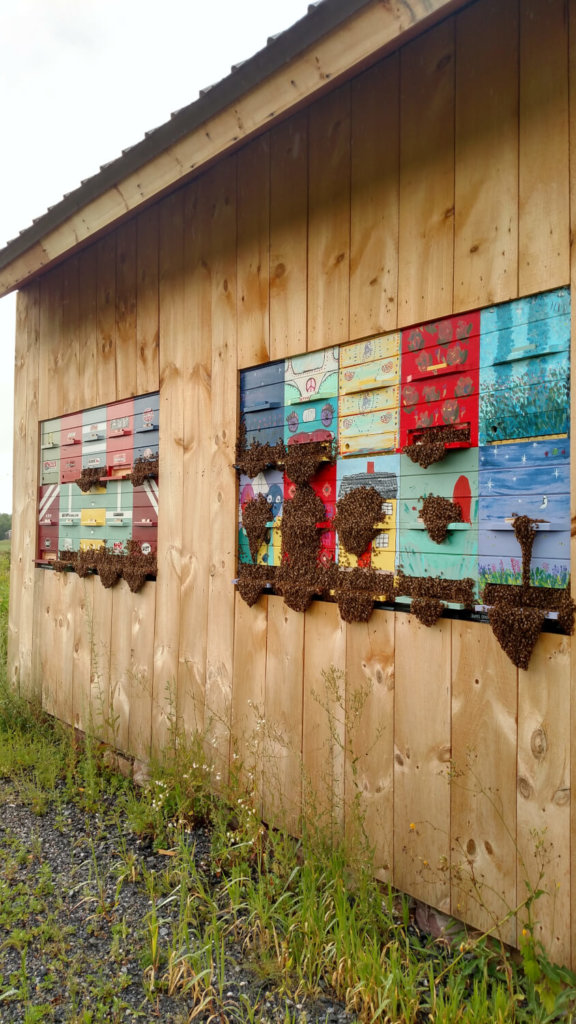Slovenian bee buildings provide a peek into the lives of honeybees

Slovenian Bee Building sounds like the name of a cool band or a drink for sale at Starbucks. What it is, though, is a method of beekeeping that has been around for eons but never on a large scale in Vermont. Peter Demick of Charlotte has one, and the results are fascinating.
Demick’s farm is tucked back on a long driveway, hidden from the road, on East Thompson’s Point. He says he doesn’t welcome many visitors, and his bees aren’t a business venture—just an expensive hobby, but one that provides hours a day of entertainment.
A traditional beehive typically seen across the U.S. and Vermont is called a Langstroth hive. It consists of painted boxes stacked vertically; Demick said he had them for a dozen years before he decided to build the Palm Beach mansion for bees that is currently filled with 800,000 happy and, yes, busy residents.
The outside of the Slovenian bee building looks like a regular shed or farm outbuilding from one side; the south side, though, looks like something out of a fairy tale. The entrance and exits of the hives themselves are about four feet off the ground, their exteriors painted with primary colors. Inside, the building is light and airy and smells like freshly cut wood; a large picture window looks out onto a field of sunflowers. Though it’s noisy and abuzz on the outside of the building, the buzzing is muted and almost peaceful on the inside.
The advantage of the Slovenian hive structure is that instead of stacking the bees on top of each other, their honeycombs are slid side by side into the hive. “Everything’s on a stainless steel slide so you can pull them in and out,” Demick said.
This enables the beekeeper to disrupt, if need be, one section of the hive at a time, instead of picking up the whole thing just to get to one of the hives on the bottom. This makes the bees less stressed, and less angry, and therefore less likely to sting.
Another perk of this system is the screens put over the back of the hive inside the building. Demick said, “The best part is, when you have a Langstroth hive, you can’t actually see what’s going on in your beehive, because there’s only the entrance and you’d have to stick a scope up there to see.” There’s a screen on the back of each separate hive; Demick’s contains space for 12 separate hives, but currently only 10 are occupied. A little wooden door protects the back of each hive, and opening one reveals a loud buzz and a peek into the world of the honeybees. There’s a chamber on the bottom for the queen and a grow chamber for her minions to live above her without her going “upstairs,” as Demick said, to disturb them.
Demick uses a flashlight to peek in on the bees and see what they’re up to and said he can spend a couple hours a day just watching them and observing their behavior.
“The coolest thing is that you can sit and watch, and actually, if you turn a light right, you can see them all working. You can look way back into the hive…you can’t do this with any other kind of hive.”
An overhang above the outdoor entrance to the hive protects the bees from rain and midsummer heat. When it’s rainy or too warm, Demick said, the bees just hang out “like a beard” outside the entrance, but they don’t get wet. He said that Langstroth hives sit on the ground and can absorb moisture that comes from rain and snow and can develop mold and mildew. In the Slovenian bee building, there’s barely any moisture that makes its way into the honey. “My honey has between 11 and 15 percent less water,” Demick said.
The funny thing is, Demick doesn’t even eat honey. He said he gets “about three to four hundred quarts of honey a year; we get 60 pounds of honey out of one setup.” He gives the honey to friends and neighbors. The joy of beekeeping comes for him not from making money but from helping a struggling bee population recover from recent drops that occurred from pesticides and Varroa bees, which are parasites that live on honeybees.
He also gets a kick out of watching them. “They’re fascinating little things,” he said. To keep his bees in a good mood, Demick also recently planted 15 pounds of wildflower seeds. “That helps make them happy.”
This hobby isn’t an inexpensive one, at least when the bee condo on your farm is, as Demick said, “the largest one in America.” The building was formerly located on the Foote Farm, which is now the site of Philo Ridge Farm in Charlotte. Demick, who is a stone mason professionally—“I play with rocks,” he said—created the stone fireplace and rock walls there.
All told, Demick estimates that he spent about $35,000 on the project, which includes insulating the building so that it doesn’t get below 20 degrees or so in the winter.
“Langstroth hives are subject to the wind, the rain; even if you put a blanket around there, when it’s 20 below, those bees are cold. Fully insulated to R40 and floors to R60. And they love it.” He also noted that the other type of hive needs to be brushed from snow in the winter so the bees don’t suffocate.
Demick acknowledges with a smile, “For a hobby, the building’s a little over the top,” which could be the reason why Slovenian bee hives haven’t taken off for beekeepers in the U.S., but it’s well worth it. He just loves the bees and the work they do.
“It’s stunningly incredible,” he said.

